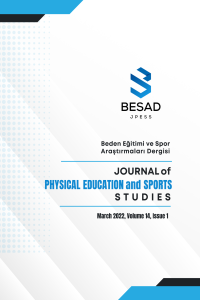Pilates Eğitici Eğitimine Yönelik Bir İhtiyaç Analizi Çalışması
Bu araştırmanın amacı pilates eğiticilerinin eğitim ihtiyaçlarını belirlemektir. Durum çalışması modeline göre desenlenen araştırmada 3 yönetici, 9 eğitmen ve 14 üyeden olmak üzere toplam 26 katılımcı ile odak görüşmeler yapılmıştır. Görüşmelerle elde edilen nitel verilerin analizinde içerik analizi yöntemi kullanılmıştır. Katılımcılar ile yapılan görüşmelerle pilates eğitici eğitiminde temel alan bilgi ve becerileri, iletişim becerileri, uygulama bilgi ve becerileri, ortam düzenleme bilgi ve becerileri ve ölçme bilgi ve becerileri olmak üzere beş boyutta bulgular elde edilmiştir. Temel alan bilgi ve becerileri boyutunda katılımcılar pilates eğiticilerinin temel spor, sağlık ve anatomi bilgisi edinmeleri gerektiğini belirtmişlerdir. Uygulama sürecinde ise katılımcılara göre pilates eğiticileri seviye grupları oluşturma, düzeltmeler yapma ve geribildirimler verme gibi bilgi ve becerilere sahip olmalıdır. Katılımcılara göre pilates eğiticileri iletişim becerilerini etkili bir şekilde kullanabilmelidir. Pilates eğitiminde özellikle ortamın ferah olması, aynaların ve müziğin bulunması katılımcılar tarafından belirtilmiştir. Ölçme boyutu içinse katılımcılar pilates eğiticilerinin vücut ölçümleri yapabilmeleri gerektiğini belirtmişlerdir
Anahtar Kelimeler:
Pilates, Eğitici Eğitimi, İhtiyaç Analizi
A need analyses for pilates educational training
The aim of this study is to specify the needs of Pilates instructors’ educational needs. In this study which was designed as a case study, focus interviews were conducted with 26 participants whose 3 of them managers, 9 of them instructors and 14 of them members. Content analysis method was used in the analysis of qualitative data that was obtained from the interviews. In the interviews with participants, findings in five dimensions were obtained in Pilates educational training as basic knowledge and skills, communication skills, practice knowledge and skills, environment regulation knowledge and skills and measurement knowledge and skills. Participants in the basic knowledge and skills dimension indicated that Pilates instructors need to obtain basic sports, health and anatomic knowledge. In the practice knowledge and skills dimension, according to the participants, Pilates trainers should have knowledge and skills such as creating group levels, making corrections and giving feedback. According to participants, Pilates instructors should also be able to use communication skills effectively. In the Pilates training, especially the spaciousness of the environment, the presence of mirrors and music was indicated essential by the participants. For the measurement dimension, participants indicated that Pilates trainers should be able to make body measurements.
Keywords:
Pilates, Education of Instructor, Need Analysis,
___
- Abramaviciute, V., Zaicenkoviene, K., Sujeta, A. (2013). The influence of pilates exercise on women’s anthrophometry indices, core muscle performance and heart rate changes during the session. Lithuanian Sports University, Education, Physical Training Sport, 2(89), 5- 11.
- Aladro-Gonzalvo, A. R., Machado-Díaz, M., Moncada-Jiménez, J., Hernández-Elizondo, J., ArayaVargas, G. (2012). The effect of pilates exercises on body composition: A systematic review. Journal of Bodywork and Movement Therapies, 16(1), 109-114.
- Appell, I. P. C., Perez, V. R., Nascimento, M. D. M., Coriolano, H. J. A. (2012). The pilates method to improve body balance in the elderly. Archives of Exercise in Health and Disease, 3(3), 188- 193.
- Bernardo, L.M. (2007). The effectiveness of pilates training in healthy adults: An appraisal of the research literature. Journal of Body Work and Movement Therapies, 11, 106-10.
- Cancela, J. M., de Oliveira, I. M., & Rodríguez-Fuentes, G. (2014). Effects of pilates method in physical fitness on older adults. A systematic review. European Review of Aging and Physical Activity, 11(2), 81-94.
- Da Cruz, T. M. F., Germano, M. D., Crisp, A. H., Sindorf, M. A. G., Verlengia, R., da Mota, G. R., Lopes, C. R. (2014). Does pilates training change physical fitness in young basketball athletes? Journal of Exercise Physiologyonline, 17(1), 1-9.
- Emery, K., De Serres, S.J, McMillan, A., Cote, J.N. (2010). The effects of a pilates training program on arm–trunk posture and movement. Clin Bio Mechanics, 25(2), 124–130.
- Jago, R., Jonker, M.L., Missaghian, M., Baranowski, T. (2006). Effect of 4 weeks of pilates on the body composition of young girls. Preventive Medicine, 42(3), 177-180.
- Miles, M, B., & Huberman, A. M. (1994). Qualitative data analysis: An expanded Sourcebook. (2nd ed). Thousand Oaks, CA: Sage.
- Mamashli, S., Mahdavinejad, R., Gholamali, G. (2014). The effect of eight weeks pilates and stabilization exercises on pain and flexibility of back muscles and hamstring of women with chronic low back pain. Assian Journal of Multidisciplinary Studies, 2(2), 54-58.
- Pourvaghar, M. J., Bahram, M. E., Sharif, M. R., Sayyah, M. (2014). Effects of eight weeks of pilates exercise on general health condition of aged male adults. International Journal of Sport Studies, 4(8), 895-900.
- Rogers, K., Gibson, A.L. (2009). Eight week traditional mat pilates training-program effects on adult fitness characteristics. Res Q ExercSport, 80(3), 569-574.
- Singh, T. N., Singh, S. V. K. (2014). Effect of twelve weeks exercise program with pilates on body composition among school boys of manipur. International Educational E-Journal, 3(1), 214-220.
- Selby, A. (2002). Pilates For Pregnancy. London. Harper Collins Publishers Ltd.
- Tsai, Y. W., Liou, T. H., Kao, Y. H., Wang, K. M., Huang, Y. C. (2013). Effect of a 12-week pilates course on body composition and cardiopulmonary fitness of adults living in an urban community. South African Journal for Research in Sport Physical Education and Recreation, 35(2), 183-195.
- Yıldırım, A.; Şimşek, H. (2016). Sosyal bilimlerde nitel araştırma yöntemleri. Ankara: Seçkin Yayıncılık.
- ISSN: 2602-3644
- Yayın Aralığı: Yılda 2 Sayı
- Başlangıç: 1990
- Yayıncı: Türkiye Beden Eğitimi Öğretmenleri Derneği
Sayıdaki Diğer Makaleler
Beden Eğitimi ve Spor Öğretmenliği Bölümü Öğrencilerinin Siber Aylaklık Davranışları
Türkiye' de Spor Yönetimi Değerlendirmesi: Spor Yöneticisi Görüşleri
Pilates Eğitici Eğitimine Yönelik Bir İhtiyaç Analizi Çalışması
Mehmet İNAN, Bülent ÖZDEN, Merve BAL, Songül ERDEM, Öznur YURTBAŞI, İlkay YÜCE, Kübra KESKİN
Spor Lisesini Kazanan ve Kazanamayan Öğrencilerin Yetenek Test Puanlarının Karşılaştırılması
Fatma ÇELİK KAYAPINAR, İlknur ÖZDEMİR, Kamil DİKİCİ
Fiziksel Etkinlik Karnesi Uygulamaları Değerlendirme Ölçeğinin Geliştirilmesi
